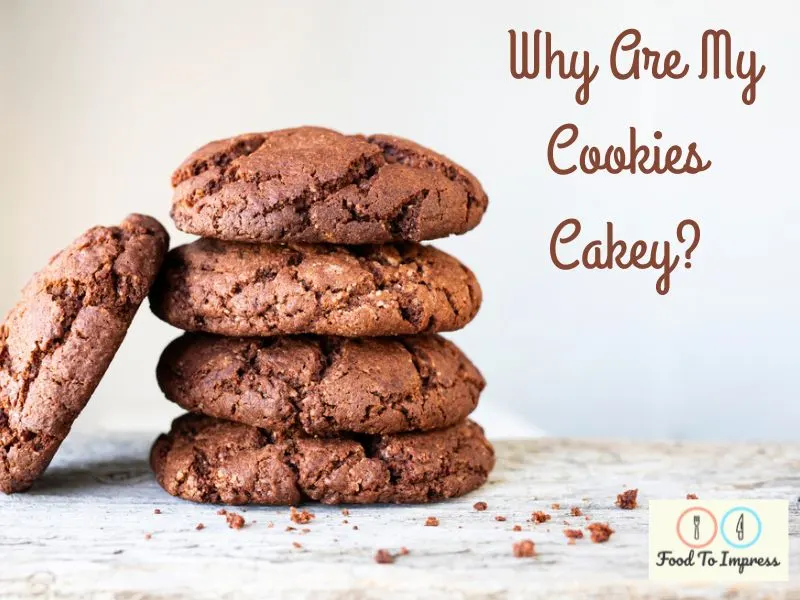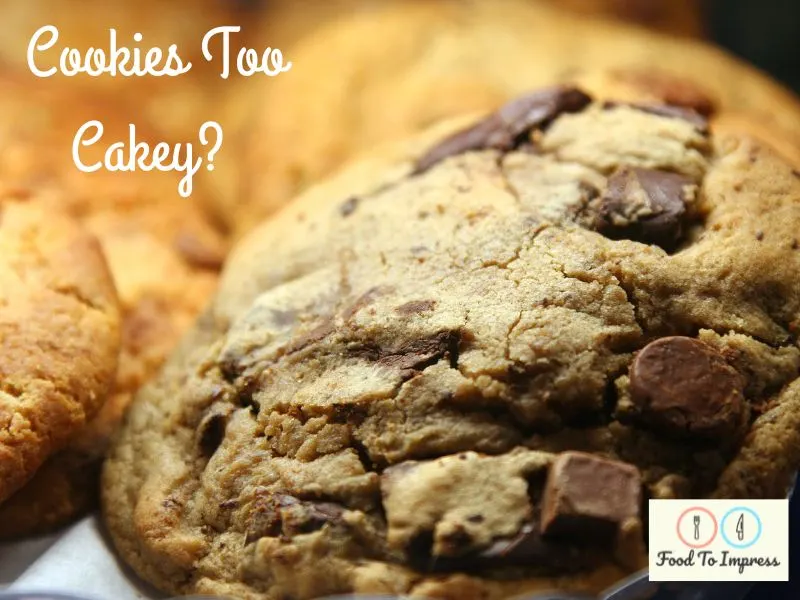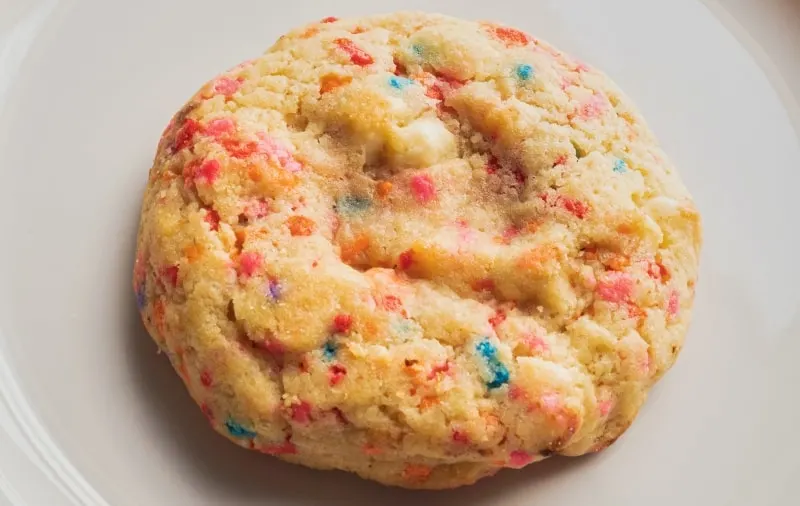Although some people like cakey cookies over the other types, it’s fair to say that most people prefer either a thin and crispy cookie or a chewy one. Since you’re here, I am guessing your are wondering ” why are my cookies cakey ” . I think it’s fair to assume that you tried to make one of these two types of cookies, but you ended up with cakey cookies instead.
If you’ve made this mistake, it’s not the end of the world. Unless the cookies are heavily overbaked, they should still taste pretty good. Take this as a lesson so you can figure out where you went wrong and see what you can do next time to prevent it. To help you with that, I’m going through what causes the cakey texture and what you can do next time to prevent it.
When cookies are cakey, it’s often because the fat:sugar:flour ratio is off. Having too much flour will generally cause drier and cakier cookies. Too much flour is usually a result of measuring it improperly. Always weigh your ingredients instead of using volume for better results.

Cookies Too Cakey?
The type of cookie you’re making is determined by the ratio of the ingredients used. Some have more butter, some have more sugar, some have more flour. If you’re not getting the ratios of the ingredients right from the start, you’ve already set yourself up for failure.
If your cookies have baked differently to how you expected, it could be due to many things, but it’s likely either because your method was off or there was something wrong with the recipe you were using. Try multiple different recipes and if you’re still having the same issue, it’s time to take a closer look into what else you might be doing wrong.
Why Did My Cookies Come Out Cakey
Unfortunately, it’s not always easy to answer the question – why are my cookies cakey? You may just have to trial and error different methods before you can figure out what you’ve done wrong.
Here are some of the reasons that might be causing that cakey texture:
The Sugar And Butter Was Overbeaten
You may have spent too long beating the butter and sugar together, which will incorporate too much air and result in a cakey texture.
If you’re using a stand mixer or handheld electric mixer, you may be making this mistake.
You don’t want to beat the butter and sugar as you would for a cake batter since you don’t want to get the same cake-like texture, so you should beat it less in order to avoid incorporating too much air.
You Used Volume Measurements
If you’re measuring large quantities of ingredients, like the flour and the sugar, then your measurements are likely to be off. Chances are that even if you think you measured the ingredients properly, you didn’t. If you’re using cups or any other volume measurement, it’s going to be at least slightly different from the recipe. This is simply because measuring in volume doesn’t produce accurate results.
When measuring in volume, flour is often the ingredient that is measured the most inconsistently. Since it’s very light and can be compacted easily, one person can measure a cup of flour 50g more or less than another person.
A mistake this small can either cause your cookies to spread out very thin as they bake or not spread out much at all. Too much spreading and they’ll be like hard crackers, and too little spread and they’ll be dense and dry.
Baking is a science, so it’s smart to measure ingredients by weight for consistent results.
Too Much Egg
Whether you added too many eggs or just added eggs that were too big, this could definitely be the problem.
Eggs are used as a leavening agent in many recipes, so if you’re adding too much, this can have an adverse effect on your cookies by making them rise up and become cakey rather than spreading out.
The leavening ability of the egg is increased if it has been beaten because the air that’s beaten into it will allow it to rise more during baking.
If you add eggs that are too large, you could land up with sticky cookie dough too so it is super important to use the right size egg.
You Used Baking Powder Instead Of Baking Soda
This is a pretty easy mistake to make. Many people don’t know the difference between the two and often consider them to be the same, but this seemingly small mistake can have a big impact on the finished result.
You see, these two leavening agents react in different ways and produce different results.
Most cookie recipes call for baking soda (bicarbonate of soda), which helps the cookies spread out during baking. Using baking powder instead will result in cookies that rise without spreading out very far, which creates a cakey texture.
So, always remember that baking soda spreads the cookies whilst baking powder puffs them up.

How To Fix Cakey Cookies
Now that you know what causes cookies to become unintentionally cakey, let’s dig deeper to learn how to fix cakey cookies the next time. Here are some useful things to consider before you try to make your next batch of cookies.
Beat The Butter And Sugar By Hand
Using an electric mixer will significantly increase the chances of you overbeating them, so it’s smarter to use your hand to manually whisk them.
There’s no doubt that it’s more difficult to beat them together by hand, but you’re going to incorporate less air and have better cookies, so I say that it’s worth it.
If you really don’t want to put too much effort into it, you can beat the ingredients with the mixer until just combined, then continue beating them by hand.
Melt The Butter Instead Of Beating It
Not all cookies need to have the butter beaten at all in order to taste great. In fact, most of my favorite cookie recipes just use melted butter.
Not only is melted butter easier, it’s also faster and cleaner. All you need to do is mix the melted butter in with the sugar before moving onto the next step.
Make sure that the butter has cooled enough before you had the egg though – you don’t want scrambled egg in your cookie dough.
Always Use Weight Instead Of Volume
There’s no doubt that baking is a science, so you need to use specific measurements. You can’t expect volume to be anything close to a specific measurement.
There’s so much room for error with volume measurements, so it’s worth scrapping those cups and getting a kitchen scale.
By measuring with weight instead, you can ensure that you get consistent results. You’ll be able to make the exact same cookies every time providing that you’re using the same oven, temperature, and baking tray. With volume, the results will be inconsistent
Volume is acceptable when measuring very small amounts of something, such as vanilla extract, salt, or baking soda. These ingredients are added in such small amounts that the tiny variations you’ll get with tablespoons and teaspoons will be negligible.
Make Sure You’re Using The Correct Leavening Agent
Don’t mix up baking powder and baking soda or the results simply won’t be what you expect. Always make sure that you’re using the correct leavening agent or you’ll end up regretting it.
Most recipes will call for baking soda since it produces the best results, but make sure that you’re prepared for a recipe that may contain baking powder instead.
Tips For Next Time Your Cookies Are Too Cakey
On paper, cookies seem pretty easy, but they’re clearly not so easy in practice. There are plenty of mistakes to be made, and you’ll most likely end up making plenty of mistakes over the years. These mistakes will help you learn and become a better baker over time.
To help you avoid unnecessary mistakes, here are a few tips to remember whenever you’re making cookies.
Bake A Test Cookie First
By baking one or two test cookies from the batch of dough, you’ll get an idea of how long they take to bake and how they look after baking.
After doing a test cookie, you can adjust the temperature and/or size of the cookie dough pieces and then try them again. Once you bake a good cookie, you’ll know that the conditions are just right and you can then put the rest of the cookie dough in to bake.
Always Read The Ingredients And Recipe Carefully
Never rush a recipe or you’ll most likely end up regretting it. By rushing it, you’re increasing the likelihood that you’ll miss ingredients, get measurements wrong, or get the method wrong.
You need to make sure that you’re looking carefully at every ingredient on the list and following the method properly. If you miss an ingredient, they won’t taste right and might not bake properly. If you get the wrong quantity of an ingredient, the dough could be too wet, dry, or just not bake properly.
You’ll never want to rush a recipe again once you mess something up badly once.
Frequently Asked Questions about Cakey Cookies
Why did my cookie turn out cakey?
Too Much Leavening Agent: Using excessive baking powder or baking soda can create a rise in cookies that’s more characteristic of cakes.
Using Cake Flour: Cake flour has a lower protein content than all-purpose flour. This can result in a finer crumb and softer texture, making your cookies turn out more cake-like.
Excess Egg: Eggs provide moisture and structure. Using too many can make your cookies rise more, giving them a cakey texture.
What makes cookies chewy vs cakey?
Sugar Type: Brown sugar contains molasses, which adds moisture to the dough. This moisture is retained during baking and results in a chewier cookie. White sugar, on the other hand, tends to produce a crisper cookie.
Fat Type: Melting butter before mixing can produce a chewier cookie, whereas creaming cold butter often leads to a more cakey texture.
Flour Type: As previously mentioned, the protein content in the flour can affect texture. All-purpose flour tends to yield chewier cookies compared to cake flour.
Baking Time: Underbaking just slightly can leave the center of the cookies chewier, while baking them fully or a bit longer can give a cakey or even crispy result.
Why are my cookies like a pancake?
Too Much Liquid: If your cookie dough contains too much milk, eggs, or other liquids, it can spread excessively during baking and result in pancake-like cookies.
Warm Dough: If your cookie dough is too warm when placed on the baking sheet, it can spread more than desired. It’s often recommended to chill dough before baking.
Inadequate Leavening: Insufficient baking powder or baking soda can prevent cookies from puffing up, causing them to spread out and become thin.
What causes cookies to be too fluffy?
Over-creaming: Over-mixing the butter and sugar can incorporate too much air into the dough, leading to fluffier cookies.
High Ratio of Leavening Agents: As previously mentioned, too much baking powder or soda can cause excessive rise.
Type of Fat: Using shortening instead of butter can produce cookies that are puffier. Shortening has a higher melting point than butter, so cookies made with it retain their shape better in the oven, resulting in a fluffier texture.
The art of cookie baking is a delicate dance of ingredients, technique, and timing. Achieving the desired texture, whether chewy or cakey, hinges on choices ranging from the type of sugar and fat used to the manner of mixing and baking duration. Factors such as the specific leavening agents, the temperature of the dough, and even the type of flour can make significant differences in the final outcome. Pancake-thin or undesirably fluffy cookies are often the result of minor missteps in these variables. Ultimately, understanding these nuances ensures that bakers can adapt and refine their methods, crafting the perfect cookie to suit their taste. With practice and patience, cookie perfection is well within reach for every aspiring baker.

